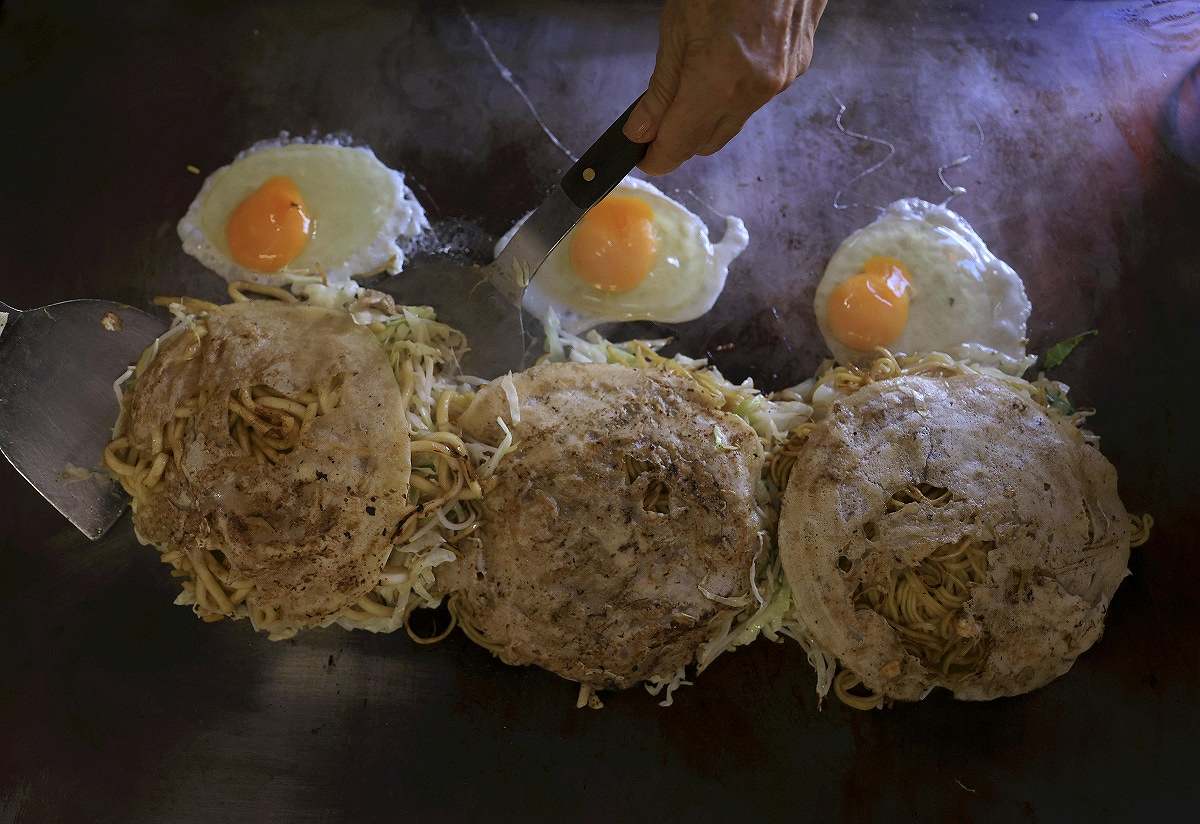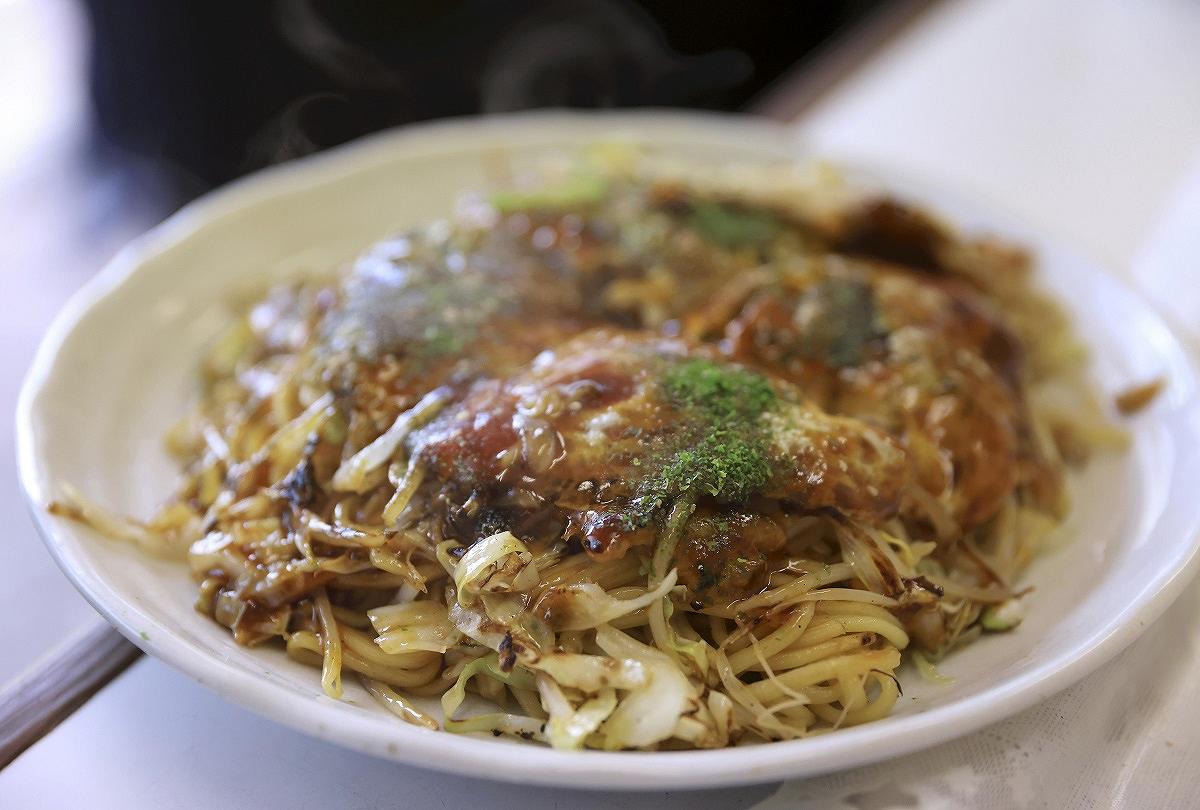
Toshiko Kajiyama works at her restaurant Okonomiyaki Kajisan in Minami Ward, Hiroshima.
14:00 JST, November 26, 2023
HIROSHIMA — The appetizing smell and sizzling sound of an okonomiyaki savory pancake being prepared on a hot griddle, or teppan, can make anyone’s mouth water.
There are many okonomiyaki restaurants around Japan, but the generosity of the woman who runs Okonomiyaki Kajisan makes the eatery quite unique, and the reason behind it is what makes the place special.
Her small okonomiyaki restaurant located in Minami Ward, Hiroshima, can only seat eight and the room is always hot, but the air is filled with the delicious smell of okonomiyaki sauce. The space is small, but it’s comfortable.
The restaurant is located near the foot of Hijiyama hill, about 10 minutes by car from JR Hiroshima Station. When I walked through the red noren curtain at the entrance, I was greeted by the owner Toshiko Kajiyama, 82, who was holding metal spatulas used for cooking okonomiyaki.
While I was there, I would occasionally see her husband, Noboru, 83, coming and going from the kitchen. Kajiyama said he goes out shopping for okonomiyaki ingredients.
“I think he wants to be of help, but he gets in the way,” Kajiyama said.
“Okonomiyaki: ¥500” is written above an old menu board in the restaurant.
An Okonomiyaki Kajisan okonomiyaki consists of pork belly, shredded cabbage, Chinese noodles covered with okonomiyaki sauce, cooked batter and a fried egg, which are all placed on top of each other.

Kajiyama’s signature okonomiyaki is made of Chinese noodles, cabbage and other ingredients.
The thick, sweet sauce goes well with all the ingredients, and the flavors are enhanced when eaten on the hot teppan.
This type of okonomiyaki would normally cost around ¥1,000 at some famous restaurants in the city.
“I haven’t raised prices for more than 30 years,” Kajiyama said.
When I asked her why, she spoke about her experiences from 78 years ago.
Orphaned
On Aug. 6, 1945, the atomic bomb was dropped near her home, which was 1.2 kilometers from the hypocenter. She was 4 years old. She has few memories of that time, but she still carries a scar on her left thigh from when she was hit by a splinter of wood.
While radioactive black rain was falling, she fled with her grandparents to a temple that was designated as an evacuation center.
After the bomb was dropped, her mother headed closer to the hypocenter to help break down buildings to prevent fires from spreading. She never returned.
“I don’t know where she died,” Kajiyama said. “We never found her remains.”
Her father had died of an illness soon after she was born, and now she had lost her mother. The atomic bombing had left her orphaned.
After World War II, she was raised by her grandparents in barracks. When she was a sixth-year elementary school student, she joined Hiroshima Kodomo o Mamoru Kai, an organization that was established to support children who became orphans after the atomic bombing until adulthood. There, she learned dressmaking, cooking and other skills. Noboru was also a part of the organization.
She married Noboru when she was 20 and gave birth to their first son at 23. Six months later, in February 1965, they renovated their house to open an okonomiyaki restaurant.
Although the couple had a few relatives, they felt that they needed to work in order to get by, so she started working right after giving birth.
At first, she planned to open a small business she could run at home while her husband was away. But once she opened the restaurant, it became her reason for living.
“I have been supported by many people after becoming orphaned by the atomic bombing,” Kajiyama said. “I can repay their kindness if I can make others happy with my okonomiyaki at this price.”
Loyal customers
Kajiyama and her husband are the only employees at the restaurant, so they think that the low price is fine as long as they don’t go into the red. But as a result of rising costs, it has become harder for them to run their business as they had in the past.
“I would rather close the restaurant than raise the price,” Kajiyama said.
Some regulars knew what she was going through, so they set up a collection box in February 2022 to support the restaurant.
The box had a sign that read, “Kajisan support fund: If you feel better after eating her delicious and affordable okonomiyaki and feel as if she gave you a warm embrace, we ask that you give a small donation.”
Many people sympathized with the idea and made donations. Regulars would put their change into the box, and customers, who found out about her restaurant through social media, also made contributions.
“I’m truly grateful,” Kajiyama said. “There are so many kind people.”
Kajiyama has been running the restaurant for 58 years, but it has not always been easy. Last year, she fell and broke her right hand, forcing her to close her shop for five weeks. She has also undergone cancer treatment and various knee surgeries, but she has never once considered closing her restaurant.
“Although my okonomiyaki is quite simple, some customers have told me it tastes nostalgic,” Kajiyama said. “As long as I have customers who come to my restaurant and like the taste, I want to continue. I think [running the shop] will also keep me in good health.”
A lush willow that survived the atomic bombing grows near the restaurant. After being exposed to radiation, the tree grew a new trunk, which is now growing branches. Kajiyama works with a smile every day to be as strong as the tree.
Shop recommendation

A regular okonomiyaki with ikaten deep-fried squid as a topping
Kajiyama recommends getting the regular okonomiyaki with ikaten deep-fried squid as a topping.
This type of okonomiyaki has been served at local shops for years and has been on the Okonomiyaki Kajisan menu since the restaurant opened.
To prepare the dish, first cook Chinese noodles on a teppan griddle with oil and coat it with okonomiyaki sauce, then pour some batter onto the griddle. After, place the noodles on top of the cooked batter, followed by ikaten, cabbage, bean sprouts and pork, then flip the okonomiyaki over. Fry an egg and place the okonomiyaki on top, then flip it over and pour okonomiyaki sauce over it before serving.
The ikaten okonomiyaki costs ¥650.
Kajiyama learned how to make okonomiyaki from an acquaintance when she opened the shop. She said the secret to making a delicious okonomiyaki is the ability to know whether it has been appropriately heated. That skill takes years of experience to perfect.
"Features" POPULAR ARTICLE
-

Sanrio to Open Museum in Yamanashi Pref. Dedicated to Founder, Exhibits Include Hello Kitty, Other Characters
-

Autumn Foliage Surrounds Visitors to Tokyo’s Showa Kinen Park
-

My Daughter No Longer Speaks to Me, But I Want to See Her and My Grandchild
-

Kumamoto: Public Bath Refurbished as Library Where You Can Chat, Take Photos
-

Frozen Vegetables: Demand Rises for Convenient, Tasty Domestic Produce
JN ACCESS RANKING
-

Tokyo Economic Security Forum to Hold Inaugural Meeting Amid Tense Global Environment
-

Keidanren Chairman Yoshinobu Tsutsui Visits Kashiwazaki-Kariwa Nuclear Power Plant; Inspects New Emergency Safety System
-

Imports of Rare Earths from China Facing Delays, May Be Caused by Deterioration of Japan-China Relations
-

University of Tokyo Professor Discusses Japanese Economic Security in Interview Ahead of Forum
-

Japan Pulls out of Vietnam Nuclear Project, Complicating Hanoi’s Power Plans
























